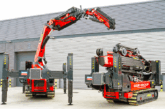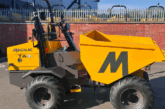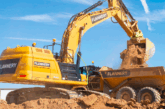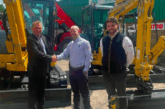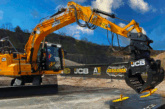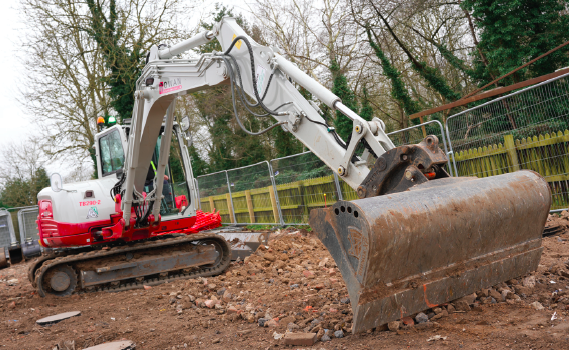
Summertime and the living is easy. Some say he takes his work boots on holiday, others that he packs his steel-toed flipflops. All we know is that we call him The Dig.
This month he gives a Takeuchi TB290-2 a few work tasks.
 Takeuchi’s 9-tonne midi excavator offering, the TB290-2, which was first introduced to the line-up in 2019, continues to be an ever-popular machine with a wide range of customers.
Takeuchi’s 9-tonne midi excavator offering, the TB290-2, which was first introduced to the line-up in 2019, continues to be an ever-popular machine with a wide range of customers.
The first series TB290 model was launched in 2014, replacing the 8.5-tonne class TB285, itself the successor to the previous 7.5-tonne class TB175, which was well liked by both owners and operators alike for its smooth hydraulics, boxy nofrills look, durability and reliability.
When the TB285 was first introduced, it featured a much more modern rounded and compact rear end, which was not only pleasing to the eye, but more importantly less prone to damage when working in tight quarters. This has continued with the TB290 and the very popular TB290-2, which with a few tweaks along the way, is now considered to be a heavyweight product in the Takeuchi line-up. In addition, since the start of this year, all Takeuchi machines now come with a 3-year/3000- hour warranty as standard, not that you are very likely to need it, such is the legendary standard of reliability of the Japanese built excavators.
We were offered an opportunity to take another look around one, on site in Daventry, the machine having recently been purchased by Northamptonshire-based Rowan Groundworks from its local dealer Willowbrook Plant.
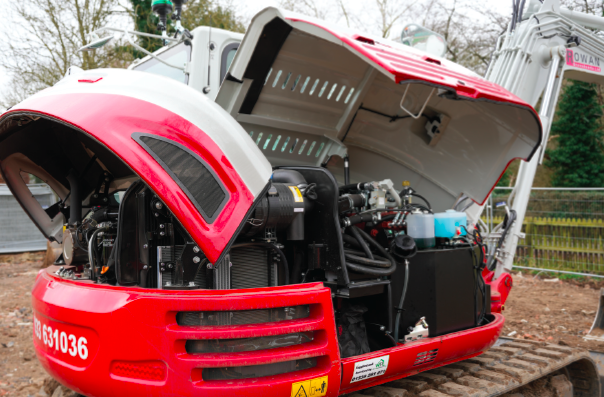
Paint job
The TB290-2, which comes with a whole raft of features as standard, is distinguished from its predecessors by the addition of red paint work which rises up along the side of the machine and drapes around the rear engine bonnet. This cosmetic splash really does set it apart from the previous model, which featured largely grey upper body work.
The rear bonnet raises up to reveal the heart of the TB290-2, the 4-cylinder turbocharged Yanmar 4TNV98CT-WTB diesel engine, which is Stage V emissions compliant, and uses a DPF to achieve these standards. It offers a power output rating of 51.6kw @2000rpm. This unit replaced the
Isuzu power pack in the previous model which was rated at 52.0kw producing a maximum torque of just 255 N/m while the new Yanmar motor produces significantly more at 308 N/m at the same rpm.
Nestling in the engine bay is the state-of-the-art Kawasaki variable hydraulic pump; this blue-chip component is larger than what was fitted on the previous models and offers vastly improved oil flow delivery which ensures enhanced hydraulic performance.
The engine and hydraulic components work in unison, enabling the machine to perform better and in a seamlessly smooth manner when using multiple functions during things like precision lifting, or tracking and slewing with a heavy load on the end. In this way you don’t get that feeling of one circuit slowing down another, or the jerkiness of movements you sometimes get from a machine with a less refined hydraulic system.
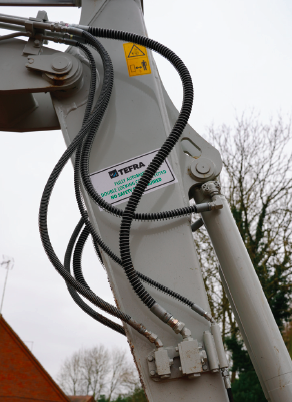
Same as on the earlier TB285 and TB290 models the gas strut assisted gull wing bonnet cover on the offside of the machine raises up to reveal a host of tightly packed in components including the main valve block, hydraulic oil tank, expansion bottle and screen wash bottle, which are located side by side and the 128-litre fuel tank. An. electric refuelling pump is fitted as standard and a handy sight tube, with the familiar floating red ball, is located down the side of the tank so you can easily gauge when refuelling is complete. The diesel tank filler point can also be accessed via the smaller lockable opening side panel too, which is very handy, rather than lifting the whole canopy, especially if filling up from a bowser.
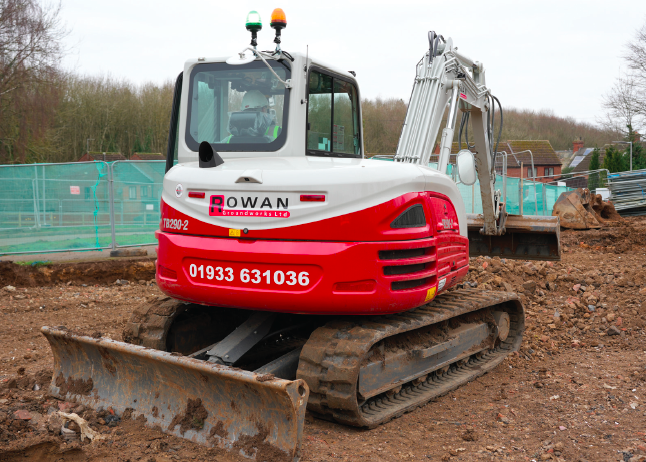
Lighting up time
The TB290-2 now features a full LED work light package which comes as standard; this one features an impressive rooftop lightbar, two boom mounted lights and one forward facing on the offside canopy.
Additional lights can be fitted to meet the specific customer’s needs. This machine is fitted with the standard boom and long arm combination which offers a maximum reach at ground level of 7,290mm and a maximum dig depth of 4,580mm. Also, as standard boom and dipper check valves are factory fitted and the machine pre-piped for 3rd auxiliary lines. Boom off-set is 70° to the right and 60° to the left.
I have always been impressed with the twin boom lift ram set-up on this 9-tonne model. It gives the boom far more stability and powerful lift performance overall. The only bit of negativity is the procedure for the quick coupler, which involves using your heel on a pedal to the right-hand rear of the floor while pressing a button on the righthand joystick. Sometimes it can be a bit tricky, and if you release the button on the joystick too early, you have to go back and start the whole procedure again, but it is what it is and you would get used to it.
Our example featured the standard fitment 450mm rubber tracks, with an overall track length of 2855mm. Other options including steel track shoes are available on request. Track guards can also be specified but this machine was not fitted with them. At the business end of the dipper this machine was fitted with a Tefra fully automatic hydraulic quick coupler from Hill Engineering and was supplied with a full set of buckets from Rhinox, including a supersized grading/rehandling bucket.
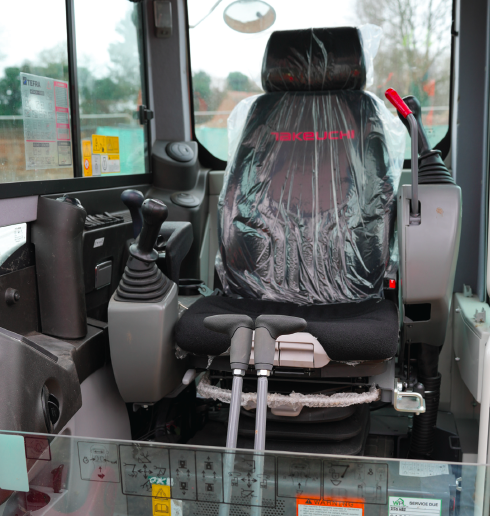
World of interiors
Climbing into the cab and it’s all that we have become accustomed to with Takeuchi machines – a nice spacious interior, with all the appointments one expects in a modern midi excavator.
Everything you could possibly need is fitted in the cab, with standard fitments being full climate control air conditioning and Bluetooth mobile phone connectivity. For improved cab comfort, there are no less than five air vents located around the cab, to provide a good flow of hot or cold air as required to suit the climate and another nice little feature is that all important cup holder, but with quite literally a special twist. By rotating the cup holder slightly, it opens up ventilation holes in the bottom, which depending on the climate control setting, can keep your beverage hot or cold. It’s a neat feature that, in all fairness, often goes unnoticed by operators until it’s pointed out to them.
For fresh air freaks, the two offside windows can both open independently by means of sliding, and of course the top front screen can be raised up, and the bottom portion can be stored at the rear of the cabin. In addition, the main cab door can be locked in the open position as per the industry standard.
The full colour monitor offers a whole host of information to the operator in a clear, easy to use and read format. The main screen reverts automatically to a rear-view camera as soon as reverse tracking is activated for improved safety not only for the operator, but for any ground crew who might have accidentally entered the working area.
Operators can also pre-set auxiliary modes on the VDU to match individual attachments flow requirements. The machine also features TFM, Takeuchi’s new telematics system. This monitoring system keeps an eye on the overall health of the machine remotely and effectively can minimise any potential downtime. Features include remote diagnostics that reduce service trips by capturing run hours and equipment data.
Utilisation tracking allows the operator to make decisions based on actual equipment use, and schedules maintenance. This saves time, parts and money by avoiding unnecessary maintenance. In addition, TFM minimises cost by accurately identifying the problem as soon as it starts.
Visibility all around is exceptionally good, there is plenty of glass, and with mirrors fore and aft and of course the previously mentioned rear view camera, the operator is always assured a good view of the job site from any angle.
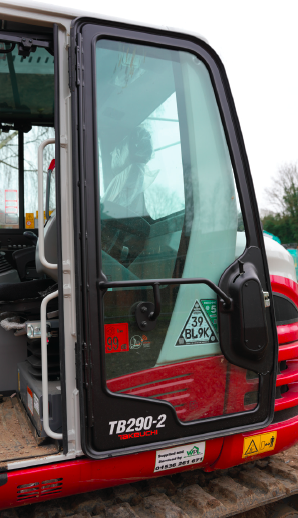
Nicely appointed
Invited to take the machine for a spin, I was impressed with the three-stage hydraulic isolation lever on the left-hand joystick console, which initially raises one step, then the console goes up, then on the last stroke the lever folds up again, to allow the operator the very best entrance into the seating area. Once I sat down, I got myself comfortable in the superb Grammer heated air suspension seat, which offers multiple adjustments for that best operating position. Surveying the surroundings, it’s all the usual stuff we are used to with Takeuchi – nicely positioned control buttons, and the throttle dial located in the recess in the righthand arm rest. It’s nice to notice the decent sized track pedals more than enough for my size sevens to fit on. To the right hand-side we find the left and right off-set arm pedal, with a footrest to the left of the track pedals.
No gimmicky push button starts on this machine, the traditional key in the ignition is great to see. Having said that the key is protected by Takeuchi’s TSS (Takeuchi security system) so you get one red master key and three black user keys, you can also programme up to 13 user keys in the system.
So, with the flick of the key the Yammar motor springs into life, after a period of warm up I gently tweaked the throttle dial to about half chat, before opening it right up, a tug on the floating blade lever and raising the boom with the right-hand joystick, I gently engaged the track pedals and headed towards a pile of recycled hardcore stored on the site.
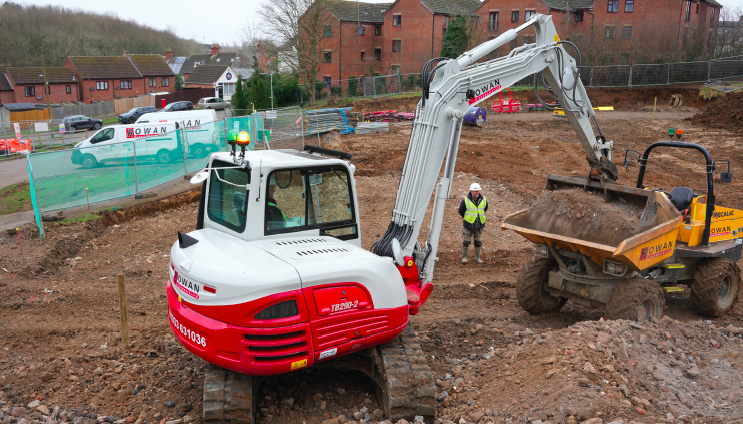
P for power
On approaching the toe of the pile, I felt I needed more power than you get in the machine’s slumbering Eco mode, so I selected the Power setting and the machine dramatically changed persona. That little bit of extra poke makes the machine perform how I felt it should do. In P mode it powered up the pile reaching the plateau on top easily.
I set myself up to trim up the sides of the pile, to weather it in, as it looked ominously cloudy and full of rain on the horizon. Considering this is just a 9-tonner, its reach down the side of the heap was impressive and nothing was too much bother for the machine.
Being very familiar with Takeuchis, I was very quickly at home and working in unison with the machine, it just does everything you expect from a quality hydraulic excavator. Having sealed up the sides, I sat atop the heap to do something that Takeuchi machines have become so well known for, grading. The smoothness of the controls is the stuff of legends, every service works as you would expect it too, cutting through the material effortlessly, in super smooth controlled motions, it really was an absolute pleasure to be onboard. I had heard tales about the machines being a little light on the back end but throwing material around even with the slightly oversized grading bucket, the machine never once felt unbalanced to me, despite my efforts to prompt a tip at full tilt! Slew speed remains as it was on the original TB285, a respectable 10.3rpm with a nicely controlled take off and slow down.
No doubt this machine will eventually be given the Takeuchi 3-Series upgrade, although from previous experience we know that the Japanese don’t like to rush into things and make sure they have everything just right before launching anything new, but at the moment, I see no need to change, as this model is as good as it gets in the 9-tonne class sector, I certainly enjoyed my time in the seat!
More information on Takeuchi

